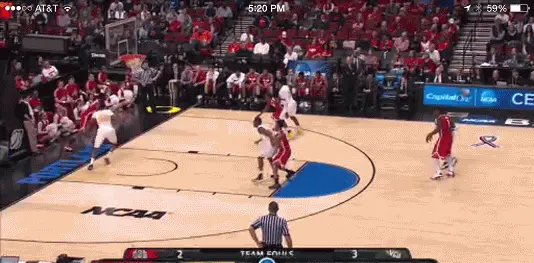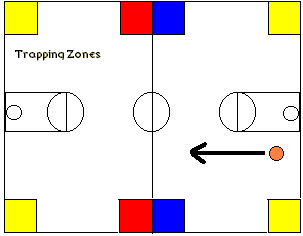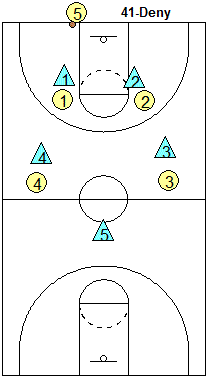Basketball Defense - Full-Court Man-To-Man Pressure Defense
By Dr. James Gels, From the Coach’s Clipboard Basketball Playbook"Helping coaches coach better..."

For our full-court press, we may simply play full-court man-to-man "pressure defense". This is a good full-court defense for younger players to play because:
- It is effective. Just a little man-to-man pressure will often cause the offense to turn the ball over. More experienced (high-school level) offensive players can break this defense down, but usually not middle-school players.
- It is easy to teach and requires little practice time. A full-court zone press on the other hand requires considerable practice time to learn it correctly.
- Players use and learn the same basic concepts of man-to-man defense (on-ball, deny and help-side defense, just extended to the full-court).
- There is little risk, or gambling, with this defense.
The full-court pressure defense is a man-to-man full-court defense. Instead of using the phrase, "we are going to press this team", I tell my players "we are going to pressure this team." A full-court zone press often implies trapping, gambling. With the "pressure defense", we do not gamble or trap much.
A zone press that emphasizes trapping is always a gamble. A good offense with quick, experienced guards can break through and score easy lay-ups. Pressure defense is not a gambling defense. It applies full-court pressure to the ball, while still protecting against the easy lay-up. It basically is the same as half-court man-to-man defense, but extended to the entire court.

The defender "on-ball" defends the ball-handler tightly using good, quick footwork, and tries to force to the sideline. To force to the sideline, the defender guarding the inbounds passer should slide a little toward the middle of the floor with arms out-stretched, so as to deny the pass to the middle and force it to the corner.
The defenders who are on the ball-side, play "denial" and stay in the passing lanes between the ball and their man. The other defenders, who are opposite the ball-side, play "help-side", and help protect the basket against the easy lay-up. So, what it looks like is, the "on ball" and ball-side defenders playing a typical man defense, while the opposite side looks like a zone back in the paint. There is a saying, "A good man-to-man looks like a zone, and a good zone looks like a man." This is very true of this defense.
All defenders must see the ball at all times. They should try to be in position to see both the ball and their man.
If the ball breaks through the perimeter, or gets up the floor ahead of any defender, all defenders except the "on-ball" defender, must sprint back to the paint to prevent the lay-up. The "on-ball" defender tries to stay with the ball and force to the sideline.
There are two ways of starting the pressure in transition. First, after a made basket or ball out-of-bounds, have each defender get on his/her assigned man.
Second, after a rebound, steal, or turnover in transition, have each defender just pick up the closest man, rather than trying to run and find their pre-assigned man. Any mismatches that occur are usually outweighed by getting the pressure started immediately, and stopping the fast-break. If the offense advances into half-court, players can "switch" at opportune moments when they are back in half-court.
Trapping, while not the primary consideration, is not completely excluded. If the offensive man bringing the ball up is caught along the sideline, or in one of the trapping areas (see below), a second defender can run over to his blind-side and trap him, hoping to create a turnover. But do not reach-in and get the foul! The other defenders then should be ready to intercept.
This full-court man defense will require the defenders to switch when they are screened. These switches must be called out loudly and happen immediately, so that the ball does not get by them. Again, any mismatches can be switched back later in the half-court if necessary, or your team can optionally drop back into a zone defense in the half-court.
Remember, good "pressure defense" is not a gambling one, but one that extends the pressure over the entire floor, while still protecting the paint. This steady, relentless pressure over the course of the game will harass and tire the opponent, and will cause the offense to make bad passes, and other turnovers that they would never make if they were allowed to dribble up the floor uncontested. "It is human to err, and pressure causes error."
See "Basic Defense" in regard to the concepts of "on-ball", "denial", "help-side", "help and recover" and trapping.
Here are a couple of good full-court drills to use:- Z-Drill
- 1-on-1 Defensive Drills (see the full-court drill)
Trapping Zones
The yellow zones catch the player in the corner.
The red zones are excellent trapping zones, since the offensive player cannot retreat across the 10 second line.
The blue zones are good trapping zones because the offense has to worry about the 10-second count.

"41 Deny"
Use this man-to-man press to deny the inbounds pass. You are going for the 5-second count, or an interception of a poorly made pass from the inbounder. With this press, the defender whose assigned person is the inbounder gets back to at least half-court or beyond as the "safety" against the long pass and lay-up.
The other four defenders immediately locate their man and deny the pass from the inbounder by playing the passing lanes and staying between their man and the ball. These four defenders should not worry about the long pass over their heads, as the "safety" is back to stop that.
See: Press Inbounds Deny Drills
